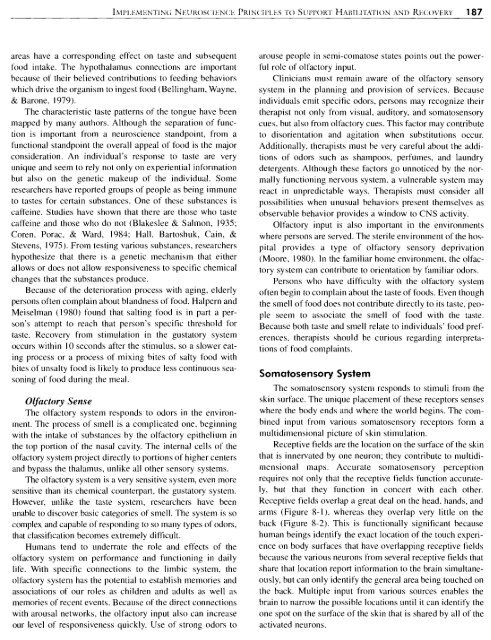Implementing Neuroscience Principles to Support Habilitation and ...
Implementing Neuroscience Principles to Support Habilitation and ...
Implementing Neuroscience Principles to Support Habilitation and ...
Create successful ePaper yourself
Turn your PDF publications into a flip-book with our unique Google optimized e-Paper software.
areas have a corresponding effect on taste <strong>and</strong> subsequent<br />
food intake. The hypothalamus connections are important<br />
because of their believed contributions <strong>to</strong> feeding behaviors<br />
which drive the organism <strong>to</strong> ingest food (Bellingham, Wayne,<br />
& Barone, 1979).<br />
The characteristic taste patterns of the <strong>to</strong>ngue have been<br />
mapped by many authors. Although the separation of function<br />
is important from a neuroscience st<strong>and</strong>point, from a<br />
functional st<strong>and</strong>point the overall appeal of food is the major<br />
consideration. An individual's response <strong>to</strong> taste are very<br />
unique <strong>and</strong> seem <strong>to</strong> rely not only on experiential information<br />
but also on the genetic makeup of the individual. Some<br />
researchers have reported groups of people as being immune<br />
<strong>to</strong> tastes for certain substances. One of these substances is<br />
caffeine. Studies have shown that there are those who taste<br />
caffeine <strong>and</strong> those who do not (Blakeslee & Salmon, 1935;<br />
Coren, Porac. & Ward, 1984; Hall. Bar<strong>to</strong>shuk, Cain, &<br />
Stevens, 1975). From testing various substances, researchers<br />
hypothesize that there is a genetic mechanism that either<br />
allows or does not allow responsiveness <strong>to</strong> specific chemical<br />
changes that the substances produce.<br />
Because of the deterioration process with aging, elderly<br />
persons often complain about bl<strong>and</strong>ness of food. Halpern <strong>and</strong><br />
Meiselman (1980) found that salting food is in part a person's<br />
attempt <strong>to</strong> reach that person's specific threshold for<br />
taste. Recovery from stimulation in the gusta<strong>to</strong>ry system<br />
occurs within 10 seconds after the stimulus. so a slower eating<br />
process or a process of mixing bites of salty food with<br />
bites of unsalty food is likely <strong>to</strong> produce less continuous seasoning<br />
of food during the meal.<br />
Olfac<strong>to</strong>ry Sense<br />
The olfac<strong>to</strong>ry system responds <strong>to</strong> odors in the environment.<br />
The process of smell is a complicated one. beginning<br />
with the intake of substances by the olfac<strong>to</strong>ry epithelium in<br />
the <strong>to</strong>p portion of the nasal cavity. The internal cells of the<br />
olfac<strong>to</strong>ry system project directly <strong>to</strong> portions of higher centers<br />
<strong>and</strong> bypass the thalamus, unlike a11 other sensory systems.<br />
The olfac<strong>to</strong>ry system is a very sensitive system, even more<br />
sensitive than its chemical counterpart, the gusta<strong>to</strong>ry system.<br />
However, unlike the taste system, researchers have been<br />
unable <strong>to</strong> discover basic categories of smell. The system is so<br />
complex <strong>and</strong> capable of responding <strong>to</strong> so many types of odors,<br />
that classification becomes extremely difficult.<br />
Humans tend <strong>to</strong> underrate the role <strong>and</strong> effects of the<br />
olfac<strong>to</strong>ry system on performance <strong>and</strong> functioning in daily<br />
life. With specific connections <strong>to</strong> the limbic system. the<br />
olfac<strong>to</strong>ry system has the potential <strong>to</strong> establish memories <strong>and</strong><br />
associations of our roles as children <strong>and</strong> adults as well as<br />
memories of recent events. Because of the direct connections<br />
with arousal networks, the olfac<strong>to</strong>ry input also can increase<br />
our level of responsiveness quickly. Use of strong odors <strong>to</strong><br />
arouse people in semi-coma<strong>to</strong>se states points out the powerful<br />
role of olfac<strong>to</strong>ry input.<br />
Clinicians must remain aware of the olfac<strong>to</strong>ry sensory<br />
system in the planning <strong>and</strong> provision of services. Because<br />
individuals emit specific odors, persons may recognize their<br />
therapist not only from visual, audi<strong>to</strong>ry, <strong>and</strong> soma<strong>to</strong>sensory<br />
cues. but also from olfac<strong>to</strong>ry cues. This fac<strong>to</strong>r may contribute<br />
<strong>to</strong> disorientation <strong>and</strong> agitation when substitutions occur.<br />
Additionally, therapists must be very careful about the additions<br />
of odors such as shampoos, perfumes. <strong>and</strong> laundry<br />
detergents. Although these fac<strong>to</strong>rs go unnoticed by the normally<br />
functioning nervous system, a vulnerable system may<br />
react in unpredictable ways. Therapists must consider all<br />
possibilities when unusual behaviors present themselves as<br />
observable behavior provides a window <strong>to</strong> CNS activity.<br />
Olfac<strong>to</strong>ry input is also important in the environments<br />
where persons are served. The sterile environment of the hospital<br />
provides a type of olfac<strong>to</strong>ry sensory deprivation<br />
(Moore, 1980). In the familiar home environment. the olfac<strong>to</strong>ry<br />
system can contribute <strong>to</strong> orientation by familiar odors.<br />
Persons who have difficulty with the olfac<strong>to</strong>ry system<br />
often begin <strong>to</strong> complain about the taste of foods. Even though<br />
the smell of food does not contribute directly <strong>to</strong> its taste, people<br />
seem <strong>to</strong> associate the smell of food with the taste.<br />
Because both taste <strong>and</strong> smell relate <strong>to</strong> individuals' food preferences,<br />
therapists should be curious regarding interpretations<br />
of food conlplaints.<br />
Soma<strong>to</strong>sensory System<br />
The soma<strong>to</strong>sensory system responds <strong>to</strong> stimuli from the<br />
skin surface. The unique placement of these recep<strong>to</strong>rs senses<br />
where the body ends <strong>and</strong> where the world begins. The combined<br />
input from various soma<strong>to</strong>sensory recep<strong>to</strong>rs form a<br />
multidimensional picture of skin stimulation.<br />
Receptive fields are the location on the surface of the skin<br />
that is innervated by one neuron; they contribute <strong>to</strong> niultidirnensional<br />
maps. Accurate soma<strong>to</strong>sensory perception<br />
requires not only that the receptive fields function accunitely,<br />
but that they function in concert with each other.<br />
Receptive fields overlap a great deal on the head. h<strong>and</strong>s, <strong>and</strong><br />
arms (Figure 8-1 ), whereas they overlap very little on the<br />
back (Figure 8-2). This is functionally significant because<br />
human beings identify the exact location of the <strong>to</strong>uch experience<br />
on body surfaces that have overlapping receptive fields<br />
because the various neurons from several receptive fields that<br />
share that location report information <strong>to</strong> the brain simultaneously,<br />
but can only identify the general area being <strong>to</strong>uched on<br />
the hack. Multiple input from various sources enables the<br />
brain <strong>to</strong> narrow the possible locations until it can identify the<br />
one spot on the surface of the skin that is shared by all of the<br />
activated neurons.





